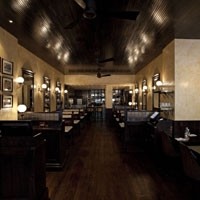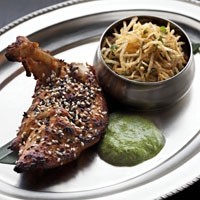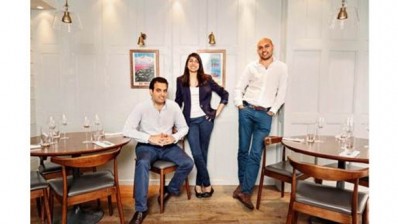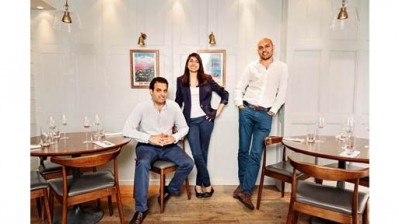Restaurant Magazine: Exclusive interview with Gymkhana chef-patron Karam Sethi

Gymkhana’s kid goat methi keema is served with two small bread rolls, a wedge of lime and a pile of finely diced onion. Bheja – or goat’s brains – can (and should) be added for a modest supplement to bring a creamy richness to the enthusiastically spiced minced meat. Shards of crispy fried potatoes are scattered over the top to provide needed textual contrast to the dish, which is served in a pleasingly battered copper pan.
This menu item – and indeed much of Gymkhana’s tandoor-led food – wouldn’t look out of place in the authentic India restaurants of Southall and Tooting, the key differentiator being the quality of the raw ingredients, the service and – commensurately – the size of the bill.
The dish would, however, look incongruous in most of the capital’s upscale Indian joints, many of which are within a few minutes walk of the Mayfair restaurant.
There are a number of things that make Gymkhana stand out from the crowd, but perhaps the most important is owner Karam Sethi’s commitment to Indian culinary tradition, and his total refusal to tone down his kitchen’s cooking for the European palate.
“The cooking here is what we call chatpatta, which roughly translates as ‘on point’, meaning the spicing and levels of sourness are just right – any more would be too much, any less would be too little,” says Sethi.
This no-punches-pulled approach has seen Gymkhana – launched in September last year – achieve extraordinary levels of success, not least now being crowned National Restaurant of the Year 2014. The London and national critics might as well have stood in a line holding up perfect 10 signs, such was the reception of the Albemarle Street restaurant. Consequently, it has been pretty much full lunch and dinner since it opened, regularly serving 90 covers at lunch and up to 140 in the evenings.
“Every little detail had been planned for two years – we had a lot of time to get things right,” says Sethi bashfully when pushed on why he thinks Gymkhana has been such an outright success.
“It’s my own pictures on the walls, all the furniture and uniforms are bespoke. The restaurant was a blank canvas, there were far fewer restrictions than at Trishna [the chef restaurateur’s first project in Marylebone]. But ultimately it comes down to good food, good drink, good service.”
The name Gymkhana references the elitist sports and social clubs of India which Sethi visited as a teenager, rather than the equestrian events. The menu is designed for sharing. A bar section lists southern Indian fried chicken wings with tomato chutney and bowls of masala peanut and lotus root chat, while the restaurant’s nashta – the Hindu word for snacks – includes brown crab tikkis served with white crab chutney and a dosa stuffed with Chettinad duck and served alongside a cooling coconut chutney.
A selection of kebabs and tikkas and game and chops is intended to form the middle section of the meal, and includes tandoori broccoli with green chilli raita, wild tiger prawns with red pepper chutney and wood pigeon pepper fry. The savoury side of the menu ends with curries and biryanis, including a spectacular pig’s cheek vindaloo and a venison biryani.
Gymkhana looks and feels reassuringly expensive, but not ostentatiously so. Like the menu, the design evokes the gentleman’s clubs of the British Raj and has a worn, established aesthetic: the ceiling is constructed from panels of lacquered oak, the tables are marble with burnished brass running around the sides and the banquettes are the colour of dark-roasted coffee.
The neatly turned bespoke furniture is the same dark oak as the ceiling and the low-slung booths in Gymkhana’s more all-day orientated street level dining room are divided by lead framed mottled glass screens. Hunting trophies, Punch sketches and Indian sports prints (Sethi is a cricket obsessive) line the walls.
Pricing is not over the top, either. With a little restraint some will get out for less than £30 a head and the average spend is £60, small change when compared to the restaurant’s expensive neighbours, which include Nobu, Novikov and The Ritz. “One of the strengths of this place is that it’s not just for special occasions. It’s OK to have a beer and a few plates at the bar,” says Sethi.
The drinks list – carefully constructed by Sethi’s sommelier sister Sunaina – has played a big role in its success. There are bespoke-brewed house beers, a totally on-trend cocktail list that includes gimlets, a punch spiked with Ceylon arrack and a lethal absinthe lassi, not to mention a stellar wine list.
Gymkhana devotes a lot more time to the sourcing of ingredients than most ethnic restaurants. For example, the slender-grained and highly fragrant basmati rice it uses is not available anywhere else in the UK and Sethi obtains some of the more temperamental spices direct from source. Wild black mustards seed hail from the mountains of Northern India and add considerable zing to a number of dishes, including the restaurant’s spiced baby potatoes.
High quality UK produce also find its way on to the menu. The restaurant makes the most of the game season, but Sethi is able to source quail, pigeon and venison all year round, the latter from Brett Graham’s Harwood Game Company, which always has either roe deer or muntjac.
“Indian spicing is a great match for game as it can cut through and complement the strong flavour. The subcontinent has a rich history of cooking with game, but shooting was banned because many of the species became endangered, although I’m sure many a Maharaja goes shooting in the grounds of his palace. You still see a bit of wild boar around,” says Sethi.
Home is where the heat is
Gymkhana’s unbridled success raises an obvious question – how on earth did a 30-year-old chef with minimal formal training launch one of the most successful restaurants in recent memory?
Sethi’s background (see The London boy with the Delhi belly) may hold some clues. He learnt most of his Indian cooking skills at the side of his mother. His experience of a professional subcontinental kitchen – with just one year spent within the kitchens at The Sheraton New Delhi – is limited.
Perversely, it seems that missing out on the prolonged apprenticeship that most high-profile Indian chefs have taken is a key ingredient to his success. “The level of spicing found in home-cooked Indian food is what I try and replicate at my restaurants,” says Sethi. “Authentic Indian food is harder to master than most people think. The complex multi-layered tastes of some dishes can only be achieved by those with considerable experience.” Sethi takes the example of the legendary kebabs of Awadhi cuisine, which originate from the state of Uttar Pradesh.
“It literally takes years to master some of these dishes – there are some that I would not attempt. They’re hugely sophisticated. There’s one with 50 different spices and the minced meat needs to be carefully laced with kidney fat to achieve the correct texture,” he says.
Precise quantities of spices and other ingredients are extremely important in Indian cuisine. A gram either way is often the difference between getting the taste right and over or under seasoning, and the order in which ingredients are added is also hugely important. As such the recipes in Sethi’s kitchens are standardised and the chef that cooks the curries comes in each and every day to ensure consistency.
“But there’s no formal development process as such,” Sethi says casually. “We cook new dishes, serve them as a staff food, perhaps tweak them a little. If we think they’ll work they go on to the menu – it’s instinctive, really.”
Despite his traditional leanings, Sethi still believes there is a place for more overtly haute Indian dining in the UK. “The great five-star hotels of India serve the food of the subcontinent in a fine setting and it’s excellent. I have no problem with Indian fine dining restaurants as long as the flavours aren’t toned down,” he says, singling out Rasoi’s Vineet Bhatia for particular praise.
Sethi regularly returns to India for inspiration and has noted major shifts in the restaurant scene. “Over the past five years there has been an explosion of international operators and chefs. Traditional Indian food has always been very strong but we’re now starting to see chefs play around, and a lot of them are taking influence from London,” says Sethi.
“Authenticity is still maintained – there’s very little French influence – but more and more chefs are looking at what Gaggan Anand [the chef at Bangkok Indian restaurant Gaggan, which is currently 17th in The World’s 50 Best Restaurants list] is doing. It’s molecular gastronomy but some of it is excellent – the big flavours and punchy spicing is retained, it’s not at all subdued.”
Despite some good experiences at some of Asia’s avant garde restaurants, a deconstructive and self-consciously innovative approach to cuisine is not something Sethi would choose to explore.
“I’ll leave that to the experts. I like it occasionally but I’d never go there myself.”
A family of restaurants
The business – which has now grown to four UK restaurants and one abroad – is a true family affair. Sethi’s older brother Jyotin has been helping him since day one, putting up much of the money for Trishna, identifying and dealing with backers and managing costs. He left a high-flying career in banking – he was an investment director at Barclays PLC – to join the business full time last year as managing director.

Jyotin is the finance whizz and keeps an eye on costs, but he also uses his considerable nous and experience of the corporate world to negotiate restaurant leases and deal with other legal processes. The group is backed by a mix of family and private investors, and with strong cash flow there are no plans to raise any more funds.
“He’s very organised and has run numerous different styles of businesses before. Jyotin is good at handling people and diffusing conflict. He just gets it. He’s our secret weapon.”
Sethi’s younger sister Sunaina followed her oldest brother into the banking world – spending a year working for HSBC in Frankfurt – but discovered a latent love of wine while helping out at Trishna in 2010. She enrolled on courses and is now a respected sommelier in her own right. She works full time for the business creating the drinks menus and overseeing front of house.
The chef’s first restaurant project certainly wasn’t an overnight hit. In 2006, a 22 year-old Sethi was introduced to the owner of iconic Mumbai restaurant Trishna and managed to strike a fee-free deal to bring it to the UK. Two years later, a smart restaurant opened on Marylebone’s Blandford Street which – on first inspection, at least – bared little resemblance to its ramshackle namesake.
The menu at the UK Trishna was (and still is) focused on the cooking of coastal India and lists some of the Mumbai restaurant’s signature dishes, including the rightly famous whole stuffed crab with butter, black pepper and garlic.
Yet despite these similarities some Indians that had been to the original accused it of losing its spice on the journey from Mumbai to London. “We got a lot of stick,” Sethi recalls. “Trishna Mumbai is a canteen-style place. At the time it didn’t seem like a good idea to bring it to London in that form.”
Sethi also points out that the menu at the original branch is enormous and varied, taking in a number of continental and even Chinese dishes.
It was a slow start, then. “We were nobodies and it took a long time to get our name out there – a good 18 months. Marylebone wasn’t the restaurant hotspot it is now and we opened just after Lehman Brothers went tits up. It was tough,” he says.
But there was another problem behind the scenes that was holding the restaurant back. Sethi and then head chef Ravi Deulkar didn’t see eye to eye, which caused significant tensions throughout the whole restaurant. About a year after Trishna opened, Deulkar left and Sethi put on an apron and jumped into the kitchen.
“I knew I could do the job. We tweaked the menu and changed the spicing of the food to make it more authentic. We also cleaned up the presentation and gave everybody more freedom.”
In 2011, Trishna won a Michelin Bib Gourmand and a year later won a Michelin star. The latter plaudit came as something of a surprise. “It was completely out of the blue – we genuinely didn’t think we could progress any further than the Bib Gourmand. After that point everything just started going right and we were able to think about branching out,” says Sethi.
It was at Trishna that Sethi identified his next restaurant project, striking up a friendship with Sandia Chang who was running the dining room at Simon Rogan’s Roganic restaurant next door.
Chang and husband James Knappett – then Marcus Wareing’s number two at his two Michelin-star restaurant at The Berkley hotel – had an idea for a casual champagne and hotdogs concept that at the time seemed rather fanciful, but has since proved to be anything but.
Sethi backed the pair and accompanied them on an extended US concept tour – taking in 40 restaurants over three days – but is quick to point out that his creative input has been minimal.
“It’s James and Sandia’s show first and foremost,” he says. “The project is a good example of what I’m looking for in my partners – young and driven entrepreneurs who want to shake things up, but don’t necessarily have the funds to do so.”
On Charlotte Street, Bubbledogs has been consistently rammed since it opened in August 2012. The gourmet hotdog-centred menu is affordable, but Chang’s selection of grower champagne ensures solid average spend per head.
Much like Trishna, Kitchen Table has been a slow burn. Semi-hidden to the rear of Bubbledogs, the ambitous tasting menu-only venture has flown low under the radar, although it has received glowing reviews.
Sethi is uncharacteristically self-assertive when it comes to Knappett’s 19-seat restaurant. “There’s no doubt it’s underrated. I ate there the other week and I think it’s the best restaurant in London. We’re happy with how it’s performing financially, but I’d like James to be seen as being in the same league as the best chefs in London.”
Last year, Sethi opened another Indian restaurant, only this time exporting a new concept rather than importing an existing one. Claus Meyer – who founded Noma with René Redzepi in 2003 – ate at Trishna in 2012 and was so impressed he invited Sethi to open across the harbour from the seminal Copenhagen restaurant in a complex formerly owned by D&D London.
The Standard has four venues: an eponymous jazz club, a casual Nordic restaurant called Almanak, a high-end Nordic affair called Studio –which recently won a star – and Sethi’s Verandah.
“The Indian food scene in Copenhagen is far less developed than the UK. There are quite a few curry houses but they’re all Bangladeshi. The project has had a good impact. People in Copenhagen get real Indian food, largely as a result of trips to the UK.”
Verandah has more in common with Trishna than Gymkhana in terms of service style but its menu cherry picks elements of both restaurants to create an eclectic but refined dining experience.
Backing the best
Following a prolonged and frustrating hunt for a site, Sethi’s second backing project opened earlier this summer, and has already proven to be another unequivocal hit. Located on the ground floor of the Tea Building in Shoreditch, Lyle’s is the brainchild of former St John Bread and Wine head chef and Young Turks alumnus James Lowe. The white washed space is reminiscent of Fergus Henderson and Trevor Gulliver’s utilitarian approach, but the cooking is far from derivative with Lowe using his considerable ingredient sourcing and cooking skills to create simple but stunning plates. Testament to Lowe’s ability, Lyle’s was named One to Watch at last month’s National Restaurant Awards.
The Sethis have had an even more hands-off approach with Lyle’s with no creative input. But, like Bubbledogs, some central office functions including payroll and marketing are shared, and Jyotin keeps a watchful eye on costs.
Sethi is a restaurant buff, checking out most of London’s notable openings. This means he’s connected and well-placed to identify which chefs and concepts to back. The Sethi’s plan to double in size over the next three years with five new restaurant projects in the works.
One non-Indian restaurant will open this year. Sethi intimates he has identified and struck a deal with the talent but is keeping his cards frustratingly close to his chest on who it is and what’s planned, largely because the group is yet to sign on a site.
Next year, two restaurants are slated to open, one non-Indian backing project and one Indian restaurant. Sethi hints that the price point of the latter will be significantly lower than Gymkhana, Trishna and Verandah at between £20-£30 a head.
“The guys behind Dishoom [in London] have done a great job. They’ve raised awareness of a different style of casual Indian restaurant that’s not a high street curry house,” says Sethi.
“We want to create a restaurant group like no other in London. We’ll do the Indian restaurants ourselves and we’ll partner with talented chefs and sommeliers to execute their projects. We’ve always wanted to be behind-the-scenes people,” says Sethi, as he strikes a Wolverine pose, somewhat reluctantly, for our cover shoot. “We generally keep ourselves to ourselves, we’re not interested in any TV work and we rarely attend industry events. We get on with what we do quietly.”
To subscribe to Restaurant Magazine here or view the digital edition here.



















